1997 年 6 月英语六级真题及答案
Part I Listening comprehension (20 minutes)
Section A
Directions: Inthissectionyou willhear10 shortconversations. At theendofeach
conversation, a question will be asked about what was said. Both the
conversationandthequestionwillbespokenonlyonce.Aftereachquestion
there will bea pause. Duringthe pause,youmust read thefoursuggested
answersmarkedA),B),C),andD)anddecidewhichisthebestanswer.Then
markthecorrespondingletterontheAnswerSheetwithasinglelinethrough
the centre.
Example:
You will hear:
You will read:
A) 2 hours.
B) 3 hours.
C) 4 hours.
D) 5 hours.
From the conversation we know that the two are talking about some work they will
start at 9 o’clock in the morning and have to finish at 2 in the afternoon. Therefore,
D) “5 hours” is the correct answer. You should choose [D] on the Answer Sheet and
mark it with a single line through the centre.
Sample Answer [A] [B] [C] [D]
1.
A) On Thursday night.
B) On Monday night.
C) On Friday morning.
D) On Thursday morning
2.
A) Try to help him find rooms in another hotel.
B) Check to see if there are any vacancies in her hotel.
C) Let him move to a room with two single beds.
D) Show him the way to Imperial Hotel.
3.
A) Robust.
B) Brave.
C) Generous.
�
D) Dangerous.
4.
A) He loves his present job.
B) He is going to open a store.
C) He is about to retire.
D) He works in a repair shop.
5.
A) She has confidence in him.
B) She has also won a scholarship.
C) She is surprised at the news.
D) She is not interested in the news.
6.
A) His only son is dying.
B) His mother died some time ago.
C) He didn’t like after his sick wife.
D) He hasn’t taken good care of his son.
7.
A) At the airport.
B) In a travel agency.
C) In a hotel.
D) At the reception desk.
8.
A) He is not equal to the job.
B) He is not well paid for his work.
C) He doesn’t think the job is challenging enough.
D) He cannot keep his mind on his work.
9.
A) The talks haven’t started yet.
B) The talks haven’t achieved much.
C) The talks have produced a general agreement.
D) The talks broke down and could go to further.
10. A) Help him to carry some luggage.
B) Get some travel information.
C) Tell him the way to the left luggage office.
D) Look after something for him.
Section B
Directions: Inthissection,youwillhear3shortpassages.Attheendofeachpassage,
�
you will hear some questions. Both the passage and the questions will be
spokenonlyonce.Afteryouhearaquestion,youmustchoosethebestanswer
fromthefourchoicesmarkedA),B),C)andD).Thenmarkthecorresponding
letter on the Answer Sheet with a single line through the centre.
Questions 11 to 13 are based on the passage you have just heard.
Passage One
11. A) Crowded air traffic.
B) The large size of airplanes.
C) Mistakes by air traffic controllers.
D) Bad weather.
12. A) They bumped into each other over a swimming pool.
B) They avoided each other by turning in different directions.
C) They narrowly escaped crashing into each other.
D) One plane climbed above the other at the critical moment.
13. A) To show the key role played by air traffic controllers.
B) To show the great responsibility shouldered by the pilots.
C) To give an example of air disasters.
D) To show that air travel is far safer than driving a car.
Questions 14 to 17 are based on the passage you have just heard.
Passage Two
14. A) Her unique experience.
B) Her future prospects.
C) Her favorite job.
D) Her lonely life.
15. A) Authority.
B) A good relationship.
C) Good luck.
D) Independence.
16. A) She will live an empty life.
B) She will work in a bookstore.
C) She will remain single.
�
D) She will earn a lot of money.
17. A) She should find a good job.
B) She should open a small restaurant.
C) She should have more control over her life.
D) She should get married.
Questions 18 to 20 are based on the passage you have just heard.
Passage Three
18. A) In day-care centers where little children were taken care of.
B) In areas in Chicago poor people lived.
C) In places where hot lunch was provided for factory workers.
D) In schools where free classes were organized for young people.
19. A) For young people and adults.
B) For immigrants.
C) For factory works.
D) For poor city children.
20. A) Jane Adams’ contributions to society.
B) Jane Adams’ struggle for women’s liberation.
C) Jane Adams’ life story.
D) Jane Adams’ responsibility for the poor.
Part II Reading Comprehension (35 minutes)
Directions: There are 4 reading passages in this part. Each passage is following by
some questions or unfinished statements-For each of them there are four
choicesmarkedA),B),C)andD).Youshoulddecideonthebestchoiceand
marktheandmarkthecorrespondingletterontheAnswerSheetwithasingle
line through the centre.
Questions 21 to 25 are based on the following passage:
It is said that the public and Congressional concern about deceptive packaging
rumpus started because Senator Hart discovered that the boxes of cereals consumed by
him, Mrs. Hart, and their children were becoming higher and narrower, with a decline
of net weight from 12 to 10.5 ounces, without any reduction in price. There were still
twelve biscuits, but they had been reduced in size. Later, the Senator rightly
complained of a store-bought pie in a handsomely illustrated box that pictured, in a
single slice, almost as many cherries as there were in the whole pie.
�
The manufacturer who increases the unit price of his product by changing his package
size to lower the quantity delivered can, without undue hardship, put his product into
boxes, bags, and tins that will contain even 4-ounce, 8-ounce, one-pound, two-pound
quantities of breakfast foods, cake mixes, etc. A study of drugstore and supermarket
shelves will convince any observer that all possible size and shapes of boxes, jars,
bottles, and tins are in use at the same time and, as the package journals show, week
by week, there is never any hesitation in introducing a new size, and shape of box or
bottle when it aids in product differentiation. The producers of packaged products argue
strongly against changing sizes of packages to contain even weights and volumes, but
no one in the trade comments unfavorably on the huge costs incurred by endless changes
of package sizes, materials, shape, art work, and net weights that are used for improving
a product’s market position.
When a packaging expert explained that he was able to multiply the price of hard
sweets by 2.5, from 1 dollar to 2.50 dollars by changing to a fancy jar, or that he
had made a 5-ounce bottle look as though it held 8 ounces, he was in effect telling
the public that packaging can be a very expensive luxury. It evidently does come high,
when an average family pays about 200 dollars a year for bottles, cans, boxes, jars
and other containers, most of which can’t be used anything but stuffing the garbage
can.
21. What started the public and Congressional concern about deceptive packaging rumpus?
A) Consumers’ complaints about the changes in the package size.
B) Expensive packaging for poor quality products.
C) A senator’s discovery of the tricks in packaging.
D) The rise in the unit price for many products.
22. The word “undue” (Para. 2) means “________”.
A) improper
B) adequate
C) unexpected
D) excessive
23. Consumers are concerned about the changes in the package size, mainly because
________.
A) they hate to see any changes in things they are familiar with
B) they unit price for a product often rises as a result
C) they have to pay for the cost of changing package sizes
D) this entails an increase in the cost of packaging
24. According to this passage, various types of packaging come into existence to
________.
�
A) meet the needs of consumers
B) suit all kinds of products
C) enhance the market position of products
D) introduce new products
25. The author is critical mainly of ________.
A) dishonest packaging
B) inferior packaging
C) the changes in package size
D) exaggerated illustrations on packages
Questions 26 to 30 are based on the following passage.
If sustainable competitive advantage depends on work-force skills, American firms
have a problem. Human-resource management is not traditionally seen as central to the
competitive survival of the firm in United States. Skill acquisition is considered an
individual responsibility. Labour is simply another factor of production to be
hired-rented at the lowest possible cost-much as one buys raw materials or equipment.
The lack of importance attached to human-resource management can be seen in the
corporate hierarchy. In an American firm the chief financial officer is almost always
second in command. The post of head of human-resource management is usually a
specialized job, off at the edge of the corporate hierarchy. The executive who holds
it is never consulted on major strategic decisions and has no chance to move up to Chief
Executive Officer (CEO). By way of contrast, in Japan the head of human-resource
management is central-usually the second most important executive, after the CEO, in
the firm’s hierarchy.
While American firms often talk about the vast amounts spent on training their work
forces, in fact they invest less in the skills of their employees than do either Japanese
or German firms. The money they do invest is also more highly concentrated on
professional and managerial employees. And the limited investments that are made in
training workers are also much more narrowly focused on the specific skills necessary
to do the next job rather than on the basic background skills that make it possible
to absorb new technologies.
As a result, problems emerge when new breakthrough technologies arrive. If American
workers, for example, take much longer to learn how to operate new flexible
manufacturing stations than workers in Germany (as they do), the effective cost of those
stations is lower in Germany than it is in the United States. More time is required
before equipment is up and running at capacity, and the need for extensive retraining
generates costs and creates bottlenecks that limit the speed with which new equipment
can be employed. The result is as lower pace of technological change. And in the end
the skills of the population affect the wages of the top half. If the bottom half can’t
effectively staff the processes that have to be operated, the management and
professional jobs that to with these processes will disappear.
�
26. Which of the following applies to the management of human resources in American
companies?
A) They hire people at the lowest cost regardless of their skills.
B) They see the gaining of skills as their employees’ own business.
C) They attach more importance to workers than equipment.
D) They only hire skilled workers because of keen competition.
27. What is the position of the head of human-resource management in an American firm?
A) He is one of the most important executives in firms.
B) His post is likely to disappear when new technologies are introduced.
C) He is directly under the chief financial executives in the firms.
D) He has no say in making important decisions in the firm.
28. The money most American firms put in training mainly goes to ________.
A) workers who can operate new equipment
B) technological and managerial staff
C) workers who lack basic background skills
D) top executives
29. According to the passages, the decisive factor in maintaining a firm’s competitive
advantage is ________.
A) the introduction of new technologies
B) the improvement of worker’s basic skills
C) the rational composition of professional and managerial employees
D) the attachment of importance to the bottom half of the employees
30. What is the main idea of the passage?
A) American firms are different from Japanese and German firms in human-resource
management.
B) Extensive retraining is indispensable to effective human-resource management.
C) The head of human-resource management must be in the central position in a
firm’s hierarchy.
D) The human-resource management strategies of American firms affect their
competitive capacity.
Questions 31 to 35 are based on the following passage.
The biographer has to dance between two shaky positions with respect to the subject.
Too close a relation, and the writer may be objectivity. Not close enough, and the writer
may lack the sympathy necessary to any effort to portray a mind, a soul-the quality
of life. Who should write the biography of a family, for example? Because of their
�
closeness to the subject, family members may have special information, but by the same
token, they may not have the distance that would allow them to be fair. Similarly, a
king’s servant might not be the best one to write a biography of that king. But a
foreigner might not have the knowledge and sympathy necessary to write the king’s
biography-not for a readership from within the kingdom, at any rate.
There is no ideal position for such a task. The biographer has to work with the
position he or she has in the world, adjusting that position as necessary to deal with
the subject. Every position has strengths and weaknesses: to thrive, a writer must try
to become aware of these, evaluate them in terms of the subject, and select a position
accordingly.
When their subjects are heroes or famous figures, biographies often reveal a
democratic motive: they attempt to show that their subjects are only human, no better
than anyone else. Other biographies are meant to change us, to invite us to become better
than we are. The biographies of Jesus found in the Bible are in this class.
allows
the
access
biographer
Biographers may claim that their account is the “authentic” one. In advancing
this claim, they are helped if the biography is “authorized” by the subject, this
presumably
information.
“Unauthorized” biographies also have their appeal, however, since they can suggest
an independence of mind in the biographer. In book promotions, the “unauthorized”
characterisation usually suggests the prospect of juicy gossip that the subject had
hoped to suppress. A subject might have several biographies, even several “authentic”
ones. We sense intuitively that no one is in a position to tell the story of a life,
perhaps not even the subject, and this has been proved by the history of biography.
special
to
private
31. According to the author, an ideal biographer would be one who ________.
A) knows the subject very well and yet maintains a proper distance from him
B) is close to the subject and knows the techniques of biography writing
C) is independent and treats the subject with fairness and objectivity
D) possesses special private information and is sympathetic toward the subject
32. The author cites the biographies of Jesus in the Bible in order to show that
________.
A) the best biographies are meant to transform their readers
B) biographies are authentic accounts of their subjects’ lives
C) the best biographies are the of heroes and famous figures
D) biographies can serve different purpose
33. Which of the following statements is true, according to the passage?
A) An authentic biography seldom appeals to its readers.
B) An authentic biography is one authorized by the subject.
C) No one can write a perfect biography.
�
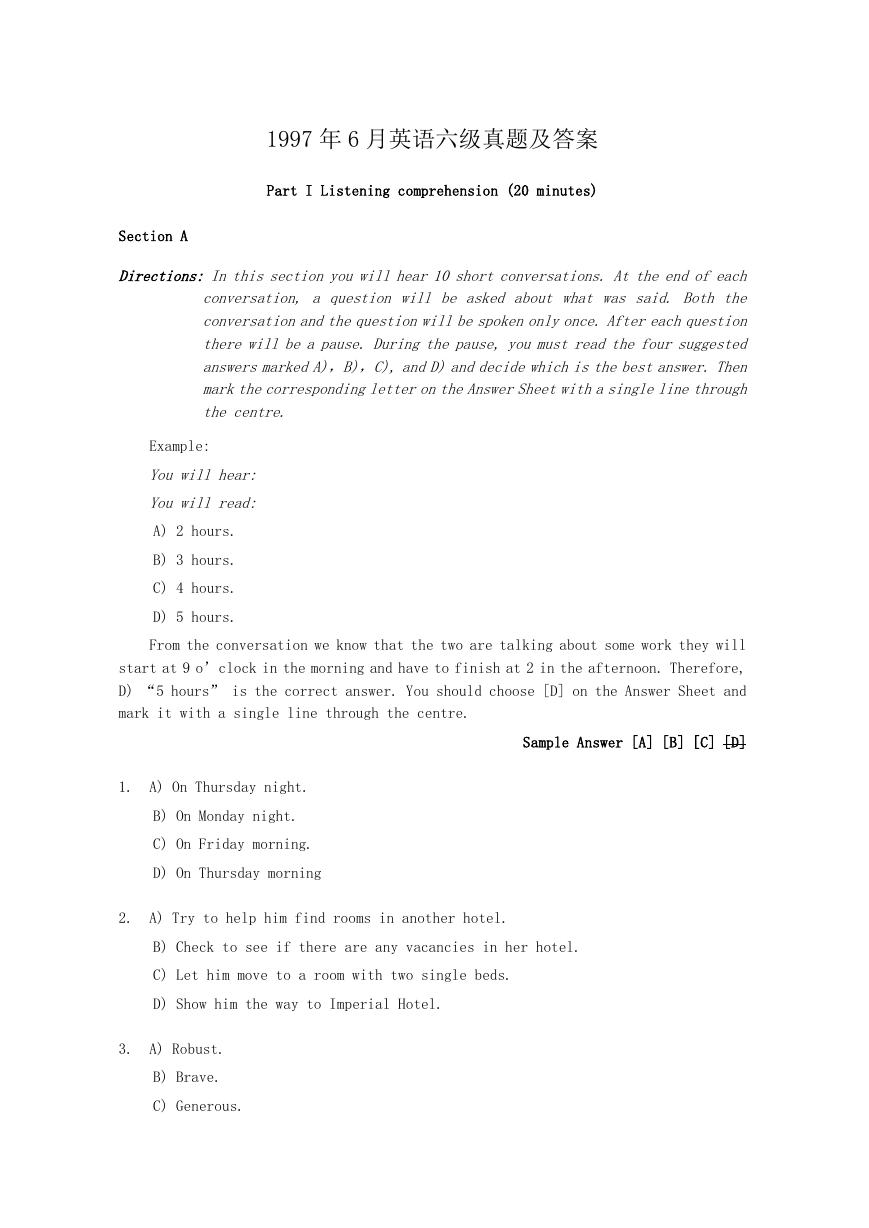

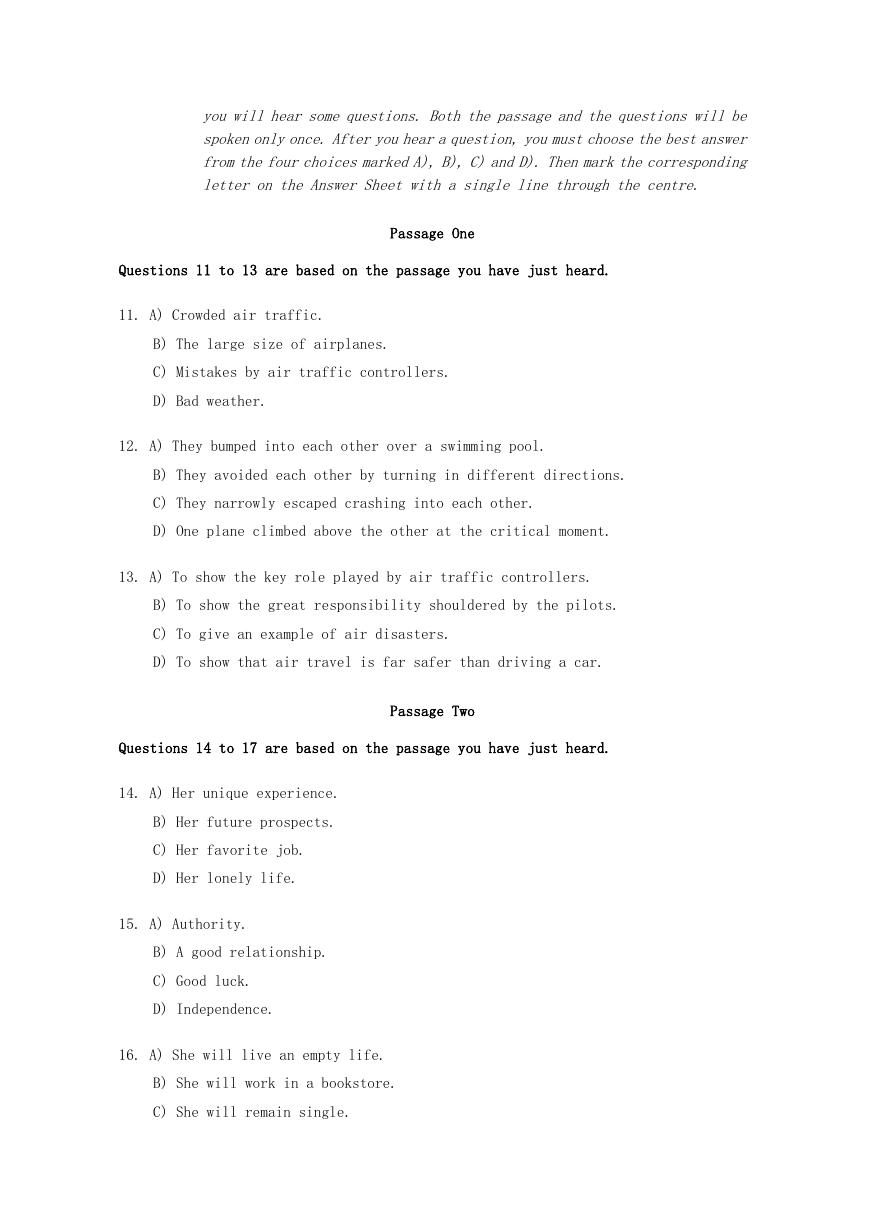
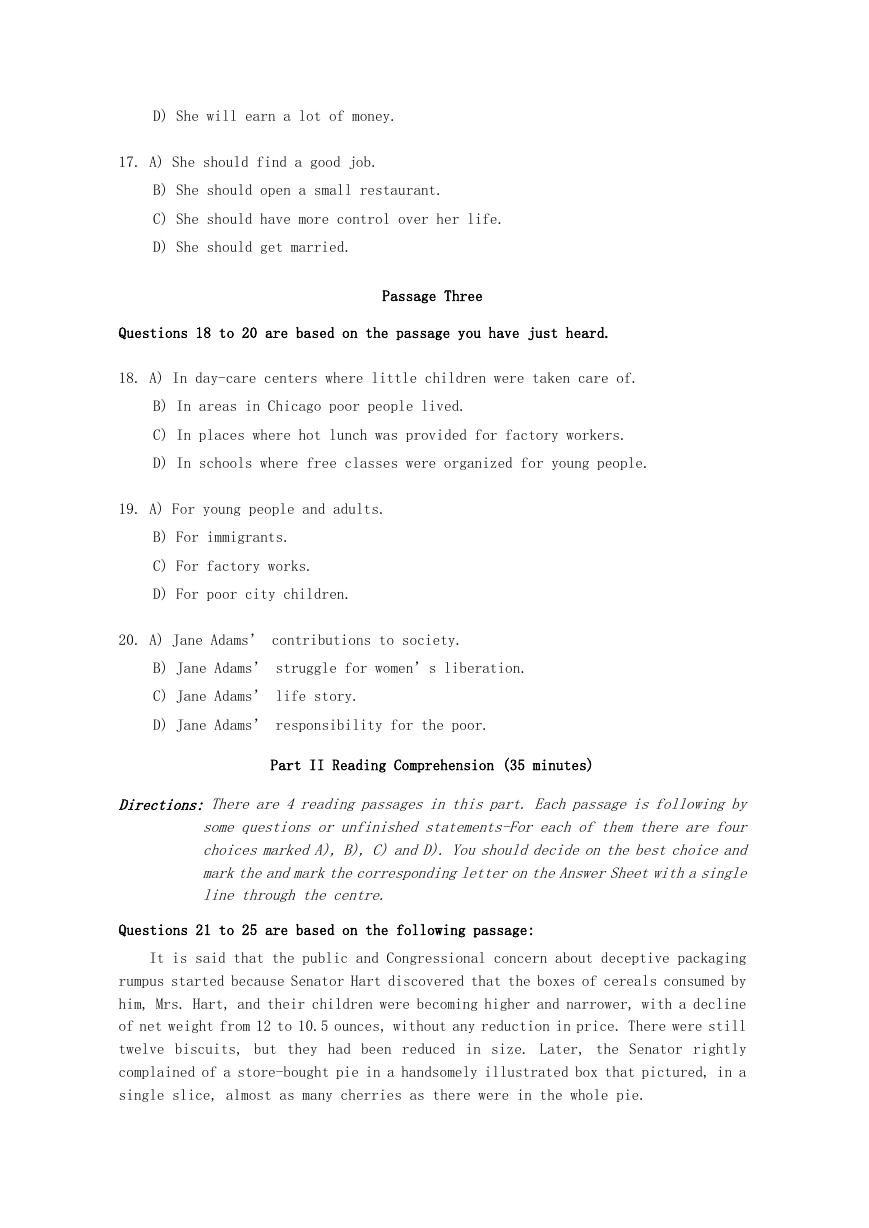
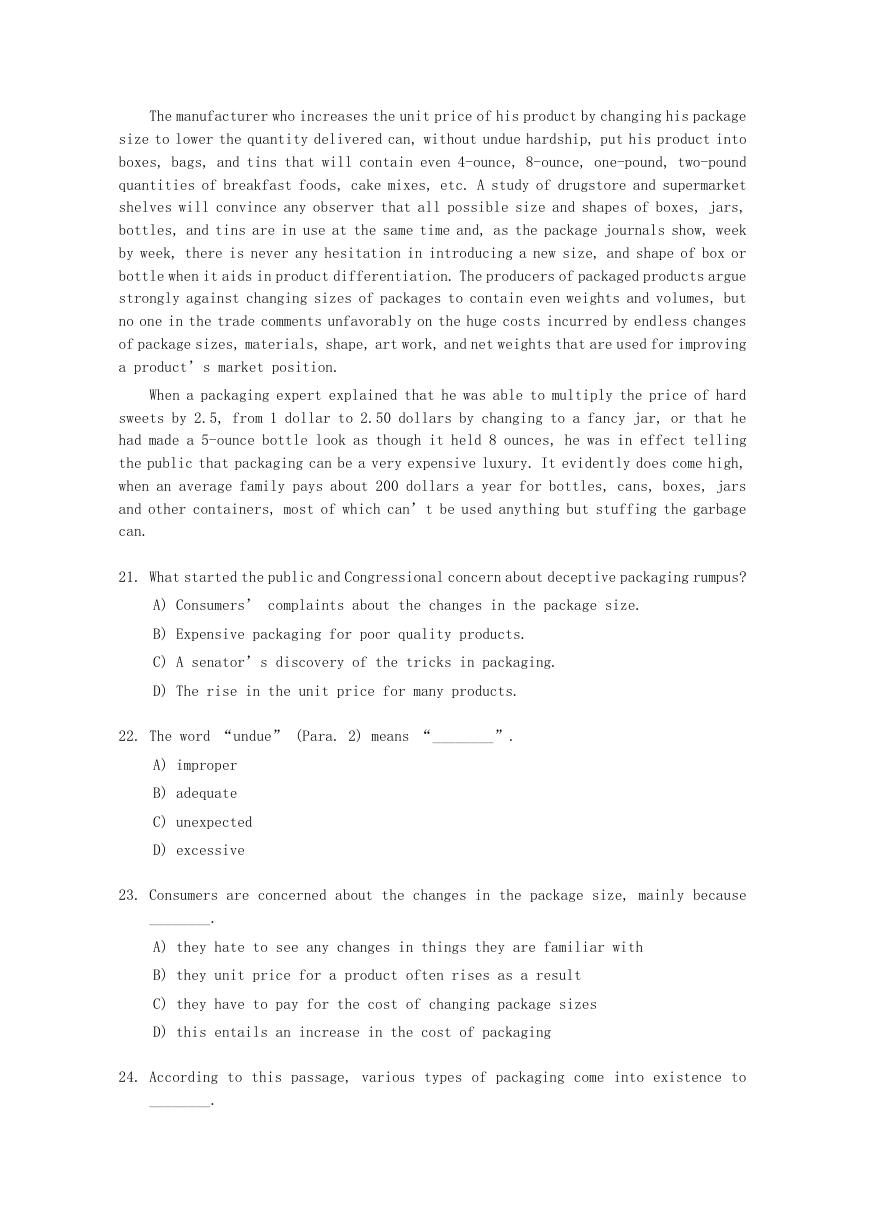
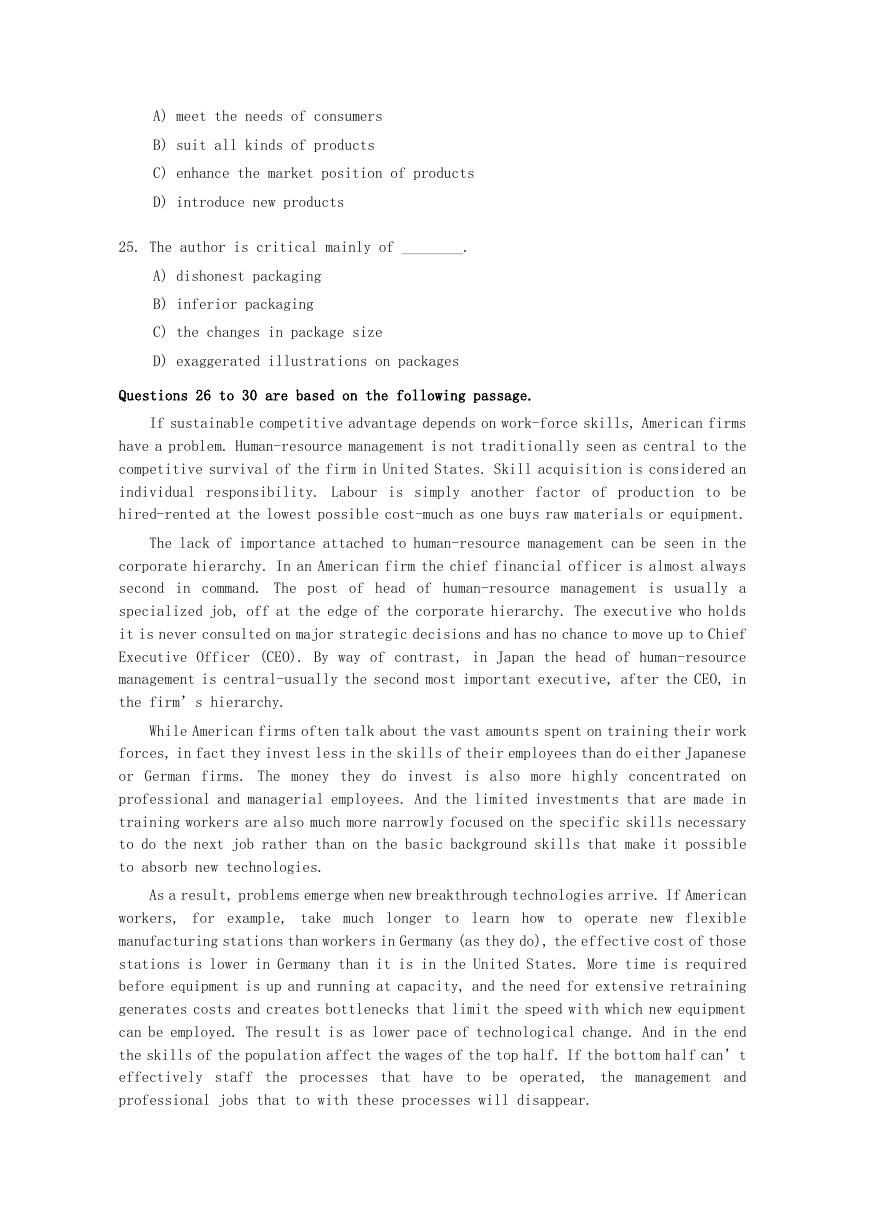
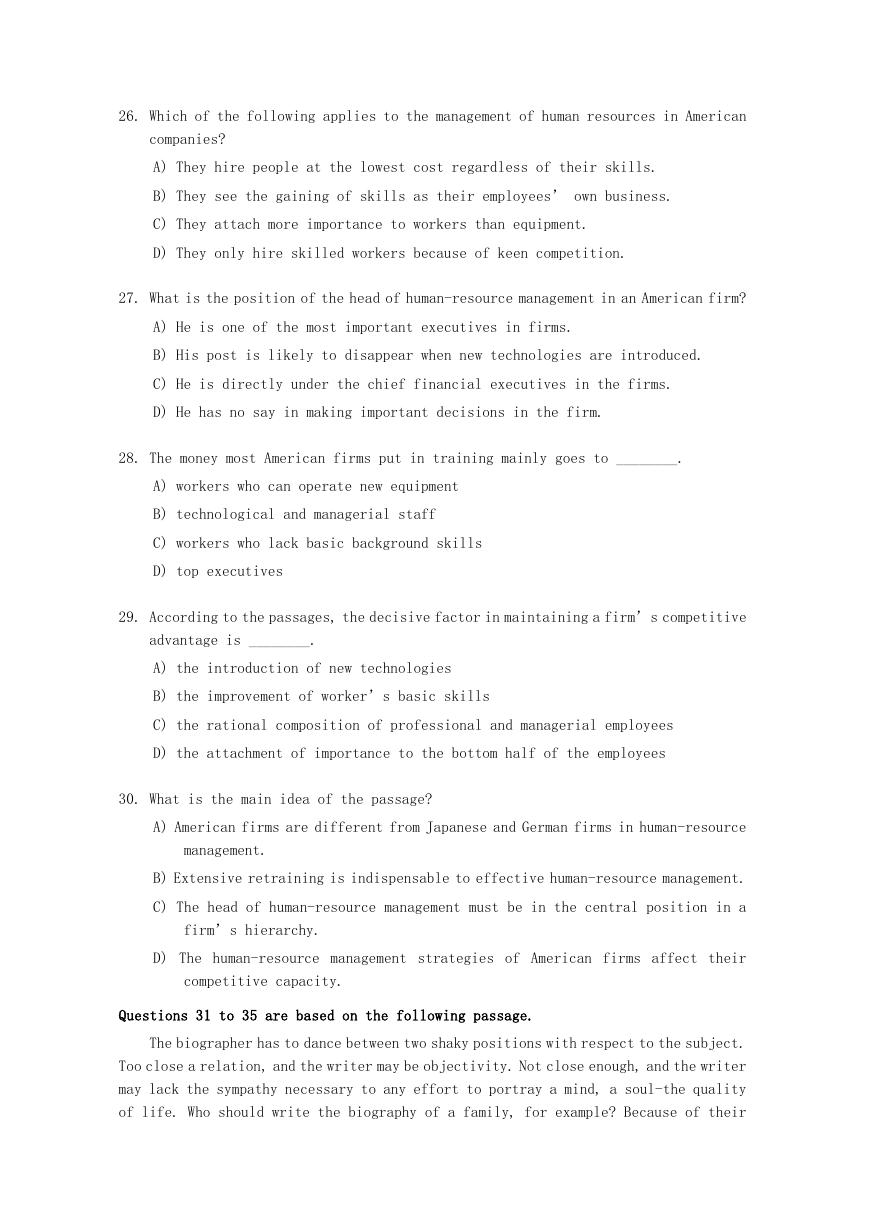









 2023年江西萍乡中考道德与法治真题及答案.doc
2023年江西萍乡中考道德与法治真题及答案.doc 2012年重庆南川中考生物真题及答案.doc
2012年重庆南川中考生物真题及答案.doc 2013年江西师范大学地理学综合及文艺理论基础考研真题.doc
2013年江西师范大学地理学综合及文艺理论基础考研真题.doc 2020年四川甘孜小升初语文真题及答案I卷.doc
2020年四川甘孜小升初语文真题及答案I卷.doc 2020年注册岩土工程师专业基础考试真题及答案.doc
2020年注册岩土工程师专业基础考试真题及答案.doc 2023-2024学年福建省厦门市九年级上学期数学月考试题及答案.doc
2023-2024学年福建省厦门市九年级上学期数学月考试题及答案.doc 2021-2022学年辽宁省沈阳市大东区九年级上学期语文期末试题及答案.doc
2021-2022学年辽宁省沈阳市大东区九年级上学期语文期末试题及答案.doc 2022-2023学年北京东城区初三第一学期物理期末试卷及答案.doc
2022-2023学年北京东城区初三第一学期物理期末试卷及答案.doc 2018上半年江西教师资格初中地理学科知识与教学能力真题及答案.doc
2018上半年江西教师资格初中地理学科知识与教学能力真题及答案.doc 2012年河北国家公务员申论考试真题及答案-省级.doc
2012年河北国家公务员申论考试真题及答案-省级.doc 2020-2021学年江苏省扬州市江都区邵樊片九年级上学期数学第一次质量检测试题及答案.doc
2020-2021学年江苏省扬州市江都区邵樊片九年级上学期数学第一次质量检测试题及答案.doc 2022下半年黑龙江教师资格证中学综合素质真题及答案.doc
2022下半年黑龙江教师资格证中学综合素质真题及答案.doc